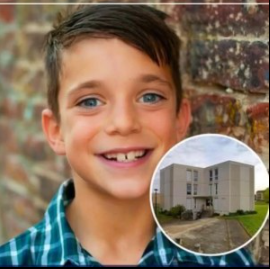“Nobody Noticed”: The Boy Who Lived Alone
In a small commune in southwestern France, nestled among quiet streets and modest council flats, a child lived a life no one should endure—let alone alone. From the age of nine to eleven, a boy survived in solitude, abandoned by his mother, overlooked by his school, and invisible to the very systems meant to protect him. For two years, he fed himself, kept warm under layers of blankets, and walked himself to school each morning. And nobody noticed.
A Life in the Shadows
The boy’s story unfolded in Nersac, near Angoulême, where he remained in the apartment his mother had vacated in 2020. She had moved just five kilometers away to live with a new partner, leaving her son behind in a flat without electricity, hot water, or adult supervision. Occasionally, she visited to drop off food. But for the most part, he was alone.
He survived on cakes, canned goods, and the generosity of neighbors who unknowingly became lifelines. He scavenged tomatoes from a nearby balcony, washed in cold water, and wrapped himself in sleeping bags to fight the chill. His days were structured around school—a place where he was known as a good pupil, clean, polite, and smiling. Teachers saw no signs of distress. His grades were steady. His demeanor, composed. And so, the silence continued.
The Illusion of Normalcy
Barbara Couturier, the mayor of Nersac, later reflected on the boy’s ability to mask his suffering. “He was smiling, a very good pupil, always clean and polite. Nothing suggested he was abandoned,” she said. “I challenge anyone who can say they would have detected this situation”.
This illusion of normalcy is perhaps the most haunting part of the story. The boy had internalized a routine that kept him afloat—school attendance, basic hygiene, and quiet resilience. In a world that often equates visible distress with need, he became invisible by doing everything “right.”
The Village That Wasn’t
There’s an old saying: “It takes a village to raise a child.” But what happens when the village doesn’t know the child is alone?
Neighbors eventually grew suspicious. One anonymously reported the situation to authorities in 2022, triggering an investigation that revealed the truth. The mother, 39, was charged with abandoning and endangering a minor. She received an 18-month sentence, with 12 months suspended and six months to be served under home confinement.
The boy was placed into care. His father, who lived in another town, was reportedly uninvolved and not charged. The community, once unaware, was left grappling with the question: How did this happen?
The Quiet Heroism of a Child
What’s remarkable is not just the tragedy—it’s the boy’s quiet heroism. At nine years old, he managed to sustain himself, maintain his education, and preserve a sense of dignity. He didn’t lash out. He didn’t drop out. He endured.
His story is not one of defiance, but of survival. It’s a testament to the human spirit, even in its smallest form. And it’s a sobering reminder that resilience should never be mistaken for wellness. Just because someone is coping doesn’t mean they’re safe.
Systems That Failed
This case exposes the blind spots in social systems. Schools, social services, and communities rely heavily on visible markers of distress. But what about the children who don’t cry out? What about those who smile through the pain?
The boy’s ability to maintain good grades and hygiene became a shield that prevented intervention. His suffering was hidden behind the very traits that should have been celebrated. It’s a paradox that demands reflection: How do we create systems that see beyond the surface?
A Mother’s Absence
The mother’s actions—leaving her son in an unheated flat while she lived nearby—are difficult to comprehend. She claimed to visit and provide food, but phone records showed she was rarely present. When confronted by neighbors, she insisted she was caring for him and told them to mind their own business.
Her sentence, though legally justified, feels emotionally inadequate. Six months of home confinement cannot undo two years of abandonment. And yet, the legal system must balance punishment with rehabilitation. The deeper question remains: What led her to this decision? Was it neglect, desperation, or something darker?
The Ripple Effect
This story is not just about one boy. It’s about every child who slips through the cracks. It’s about the assumptions we make when someone appears “fine.” It’s about the importance of asking questions, even when the answers are uncomfortable.
The boy’s resilience is inspiring, but it should never have been necessary. No child should have to prove their worth through survival. No child should be alone for two years without anyone noticing.
A Call to Awareness
In the aftermath, the mayor and community leaders have called for greater vigilance. There’s a renewed emphasis on checking in, asking questions, and listening more deeply. The boy’s story has become a catalyst for change—a painful lesson in the cost of silence.
And for those who read his story, it’s a call to awareness. Look closer. Ask more. Assume less. Because sometimes, the most heartbreaking stories are the ones that go unnoticed.


